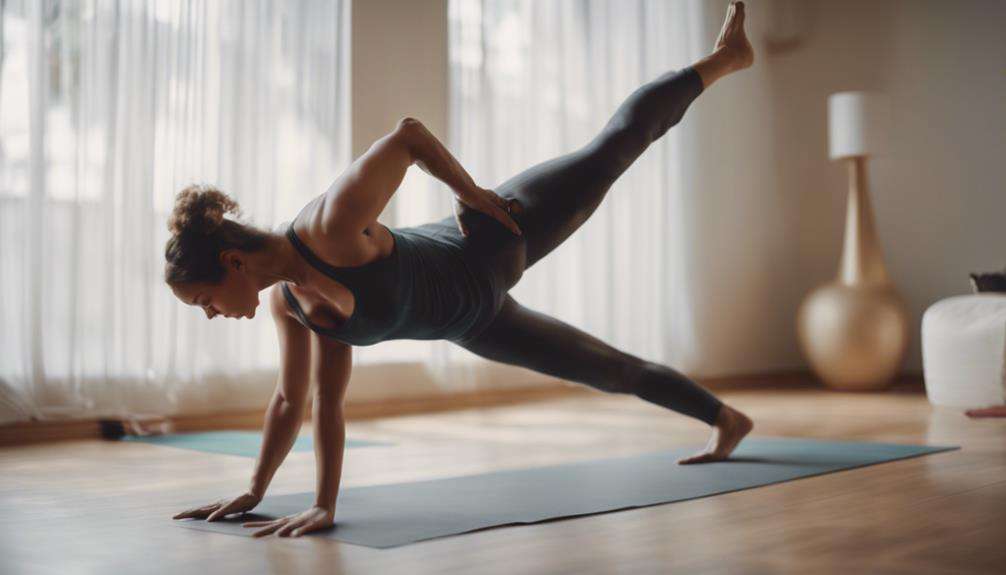Improving your joint flexibility naturally can be a nuanced journey that requires dedication and informed choices.
From simple adjustments in your daily routine to incorporating specific practices, the path to enhancing your joint flexibility offers a range of options that can suit various preferences and lifestyles.
Whether you're looking to address specific joint issues or simply aiming to maintain your overall flexibility, exploring these top 10 ways can provide valuable insights and strategies to support your joint health.
Key Takeaways
- Regular yoga practice enhances joint flexibility and overall well-being.
- Incorporating stretching exercises improves joint health and range of motion.
- Eating nutrient-rich foods and staying hydrated support joint lubrication and mobility.
- Engage in tailored low-impact exercises and manage stress levels for optimal joint health.
Importance of Flexibility in Joints
Having optimal joint flexibility is essential for ensuring a full range of motion in your daily activities. Improving flexibility through stretching exercises is key to enhancing joint health and overall well-being. Flexible joints not only allow you to move more freely but also help prevent injuries by reducing the strain on muscles and tendons during physical activities.
By increasing your range of motion, you can improve your posture and balance, leading to better coordination and stability in various movements.
Maintaining flexibility in your joints is crucial for supporting your muscles and preventing stiffness that can hinder your mobility. It also plays a significant role in enhancing your physical performance and functional ability in everyday tasks. Furthermore, flexible joints contribute to better joint health by reducing the risk of discomfort and pain associated with limited flexibility.
Embracing exercises that promote flexibility can naturally support your joints, ensuring longevity and optimal functioning throughout your life.
Benefits of Yoga for Flexibility
Improving joint flexibility through practicing yoga offers numerous benefits, including enhancing range of motion and reducing stiffness in the joints. Yoga achieves this by stretching and strengthening the muscles surrounding the joints, which helps in improving flexibility and reducing discomfort.
Regular yoga practice is known to target specific joints, promoting increased flexibility and mobility over time. Additionally, yoga aids in lubricating the joints, which can lead to better circulation and improved delivery of essential nutrients to the joint structures.
Yoga Poses for Joint Mobility

You can enhance joint mobility naturally through specific yoga poses that target different areas of the body.
Poses like Downward Dog and Warrior II can help improve flexibility and range of motion in your joints.
Regularly practicing these poses can also help reduce stiffness and enhance overall joint health.
Essential Yoga Poses
Enhancing joint flexibility naturally can be achieved through the practice of essential yoga poses that target specific muscle groups and promote mobility in the joints. Some key yoga poses that can help improve joint flexibility include:
- Downward Facing Dog: This pose stretches and strengthens muscles around the joints, enhancing flexibility.
- Tree Pose: Improves joint mobility by enhancing balance and stability in the ankles, knees, and hips.
- Cat-Cow Pose: Targets the spine, promoting movement and reducing stiffness for better joint flexibility.
- Warrior II Pose: Focuses on opening the hips and stretching the groin area, contributing to improved joint mobility.
Incorporating these poses into your yoga routine can lead to enhanced joint flexibility and overall physical well-being.
Benefits of Yoga
By practicing specific yoga poses tailored for joint mobility, you can experience notable improvements in flexibility and overall joint health. Yoga has been proven to increase range of motion and reduce stiffness in joints. Poses like Downward Dog, Warrior II, and Cat-Cow target different joints, enhancing mobility.
Regular yoga practice lubricates joints, strengthens supporting muscles, and prevents age-related stiffness. Moreover, yoga promotes joint health by boosting blood flow, reducing inflammation, and inducing relaxation in the body. Incorporating yoga into your routine can lead to improved joint flexibility, better balance, and overall well-being.
Embrace the benefits of yoga to support your joint health and enhance your quality of life.
Improving Joint Mobility
To further improve joint mobility and flexibility, consider incorporating specific yoga poses tailored for joint health. Yoga poses like Cat-Cow, Child's Pose, and Downward Dog are particularly beneficial for enhancing joint mobility. These poses focus on gentle movements that can increase the range of motion in your joints.
Regular practice of yoga not only improves flexibility but also helps reduce stiffness in the joints. By incorporating yoga into your routine, you can prevent injuries and promote overall joint health. Consistent practice of these yoga poses designed to enhance joint mobility can lead to increased flexibility and decreased joint pain over time.
Incorporating Meditation for Flexibility

Incorporating meditation into your flexibility routine can significantly improve joint flexibility naturally by reducing stress and enhancing body awareness.
Meditation helps in stress reduction, which is beneficial as high stress levels can lead to muscle tension, hindering flexibility progress. By practicing mindfulness techniques during meditation, you increase body awareness, helping you identify areas of tightness and immobility that need attention.
Deep breathing exercises incorporated into meditation promote relaxation, enabling your muscles to release tension and thereby enhancing flexibility. Additionally, regular meditation enhances focus and mental clarity, crucial for maintaining consistency in your flexibility training.
Mindfulness Techniques for Joint Flexibility
Enhance your joint flexibility naturally by practicing mindfulness techniques, such as deep breathing and meditation, to reduce stress and improve body awareness.
Mindfulness techniques play a crucial role in improving joint flexibility by promoting relaxation and reducing tension in muscles and joints.
Incorporating mindful movements like yoga and tai chi can enhance joint mobility and flexibility through their focus on fluid motions.
Additionally, practicing mindfulness can increase body awareness, leading to better alignment and reduced strain on your joints.
Mind-body techniques such as visualization and progressive muscle relaxation also aid in naturally enhancing joint flexibility by fostering a deeper mind-muscle connection.
Breathing Exercises for Flexibility

Engage your core and diaphragm muscles through diaphragmatic breathing to improve flexibility naturally. By focusing on your breath, you can enhance body awareness during stretching exercises and optimize the benefits of your flexibility routines. Proper breathing techniques play a vital role in making your stretching and strength training more effective. Various breath work methods, such as deep belly breathing, can aid in increasing flexibility and core strength simultaneously. Incorporating breath work into your flexibility routines can have a significant impact on your overall flexibility levels.
When you breathe deeply into your diaphragm, you activate your core muscles, providing stability and support during stretches. This not only helps you reach further into your stretches but also reduces the risk of injury. Developing a consistent practice of diaphragmatic breathing while engaging in flexibility exercises can lead to noticeable improvements in your range of motion and overall flexibility. Start incorporating breath work into your routine today to see enhanced results in your flexibility journey.
Role of Nutrition in Joint Flexibility
Eating nutrient-rich foods like salmon, walnuts, oranges, and strawberries can benefit your joints by reducing inflammation and supporting collagen formation.
Hydrating well and consuming antioxidants from foods like berries can help reduce oxidative stress on your joints, promoting flexibility.
Including turmeric in your diet can also aid in reducing joint pain and stiffness naturally.
Nutrient-Rich Foods Benefits
Incorporating nutrient-rich foods into your daily meals plays a crucial role in supporting joint flexibility and overall joint health. Here are some key benefits of including these foods in your diet:
- Foods rich in antioxidants such as berries and cherries can help reduce inflammation in the joints, promoting flexibility.
- Sources of omega-3 fatty acids like salmon and chia seeds support joint lubrication and flexibility.
- Vitamin C-rich foods like citrus fruits and bell peppers aid in collagen production, essential for maintaining joint flexibility.
- A balanced diet with a variety of colorful fruits and vegetables can contribute to overall joint health and flexibility.
Hydration and Joints
To maintain optimal joint flexibility, ensuring proper hydration is essential for supporting the lubrication and mobility of your joints. Proper hydration plays a crucial role in maintaining cartilage lubrication, reducing friction between joints, and supporting overall joint health.
Water intake is vital for nutrient absorption, facilitating the delivery of essential nutrients to help preserve joint flexibility. Conversely, dehydration can lead to joint stiffness and decreased mobility, highlighting the significance of staying hydrated for optimal joint function.
Including hydrating foods like cucumbers and watermelon in your diet can also contribute to joint flexibility by providing additional water content that aids in joint mobility. Remember, staying adequately hydrated is key to preventing joint discomfort and maintaining flexibility in your joints.
Hydration Tips for Flexible Joints

Proper hydration plays a vital role in maintaining joint flexibility by cushioning and lubricating the joints. Keeping your body well-hydrated is essential for ensuring your joints function correctly and move smoothly.
Here are some hydration tips to help support flexible joints:
- Drink Plenty of Water: Aim for around 8-10 glasses of water daily to support joint health and flexibility.
- Avoid Dehydration: Insufficient water intake can lead to stiff joints, reducing flexibility and impacting your overall comfort and movement.
- Protect Cartilage: Adequate hydration aids in preventing cartilage damage, maintaining joint function, especially during physical activities.
- Eat Water-Rich Foods: Include water-rich foods like fruits and vegetables in your diet as they can also contribute to joint flexibility and overall well-being.
Lifestyle Changes for Joint Health
To enhance joint health, consider making key lifestyle changes.
Focus on incorporating a balanced diet rich in nutrients that support joint health.
Engage in tailored exercise routines that promote flexibility and strength in your joints.
Remember to manage stress levels to further support your joint health.
Diet for Joint Health
Consuming a diet rich in specific nutrients can play a significant role in improving joint health and flexibility naturally. Here are some dietary recommendations to enhance joint health:
- Omega-3 Fatty Acids: Foods like salmon and chia seeds can reduce joint inflammation.
- Vitamin C: Fruits and vegetables such as oranges and bell peppers aid in collagen formation for strong joints.
- Turmeric: This spice with anti-inflammatory properties can alleviate joint pain and stiffness.
- Balanced Diet: Ensure you have adequate protein, calcium, and magnesium to support bone health and prevent joint issues.
Exercise Routines for Joints
To maintain optimal joint health and flexibility naturally, incorporating tailored exercise routines into your lifestyle is paramount. Engage in regular low-impact exercises such as swimming and cycling to improve flexibility without straining your joints. Incorporate strength training exercises into your routine to support joint health, reduce stiffness, and increase muscle strength around the joints.
Consider practicing yoga and Tai Chi, as these activities not only enhance flexibility but also improve balance and joint mobility. Avoid high-impact activities that can exacerbate joint issues and opt for gentle, joint-friendly exercises that promote overall joint health. Consistent movement through exercise routines is key to maintaining and enhancing joint flexibility in a natural and sustainable way.
Stress Management Tips
Implement stress management tips through lifestyle changes to enhance joint health and flexibility naturally. Stress can worsen inflammation and joint pain, affecting overall joint health. Consider incorporating the following strategies into your routine:
- Regular Exercise: Engage in physical activity like walking, swimming, or cycling to reduce stress levels and improve joint mobility.
- Adequate Sleep: Prioritize quality sleep to help your body recover and lower stress, benefiting joint health.
- Relaxation Techniques: Practice yoga, meditation, or deep breathing exercises to relax your mind and body, reducing stress and promoting joint flexibility.
- Mindfulness Practices: Incorporate mindfulness into your daily life to lower cortisol levels, easing joint pain and stiffness.
Consistency in Flexibility Practices
Consistency in your flexibility practices plays a crucial role in naturally enhancing and maintaining joint flexibility. Regularly engaging in stretching routines is essential for preventing stiffness and promoting better joint mobility. By incorporating flexibility exercises into your daily routine, you can sustain flexibility gains and reduce the risk of joint injuries.
Consistent stretching sessions, whether daily or frequent, are key to long-term joint health benefits. Establishing a routine that includes a variety of stretches can contribute to overall joint flexibility and function. It's important to prioritize consistency in your flexibility practices to support joint health and mobility. Remember that the more consistent you're with your stretching regimen, the more significant and lasting the benefits will be for your joint flexibility and overall well-being.
Frequently Asked Questions
How Can I Make My Joints More Flexible?
To make your joints more flexible, try yoga poses, dietary changes, stretching techniques, massage therapy, resistance training, and mobility exercises. Engage in a mind-body connection, explore herbal remedies, and consider heat therapy for optimal joint flexibility naturally.
What Are 5 Activities That Improve Flexibility?
To improve flexibility, try yoga stretches, Pilates exercises, dance movements, swimming laps, and martial arts drills. These activities enhance joint mobility, range of motion, and overall flexibility. Incorporate them into your routine for optimal results.
How Can I Regain My Joint Mobility?
To regain joint mobility, focus on a balanced routine. Incorporate stretching exercises, yoga poses, and resistance training. Explore massage therapy and joint mobilizations. Consider dietary supplements for joint health. Use heat and cold therapy smartly. Enhance stability with balance exercises.
What Are 3 Ways to Improve Flexibility?
To improve flexibility, engage in stretching exercises, yoga poses, and Pilates routines regularly. Incorporate mobility drills, dynamic movements, and resistance training into your workout routine. Consider adding massage therapy and foam rolling for enhanced flexibility gains.
Conclusion
In conclusion, improving joint flexibility naturally is like nurturing a garden – with consistent care and attention, you can cultivate strength and mobility in your joints.
By incorporating a variety of techniques such as stretching, yoga, meditation, and proper nutrition, you can enhance your flexibility and overall joint health.
Remember, just like tending to a garden, patience and dedication are key to seeing lasting results in your flexibility journey. Keep nurturing your joints and watch them blossom!






